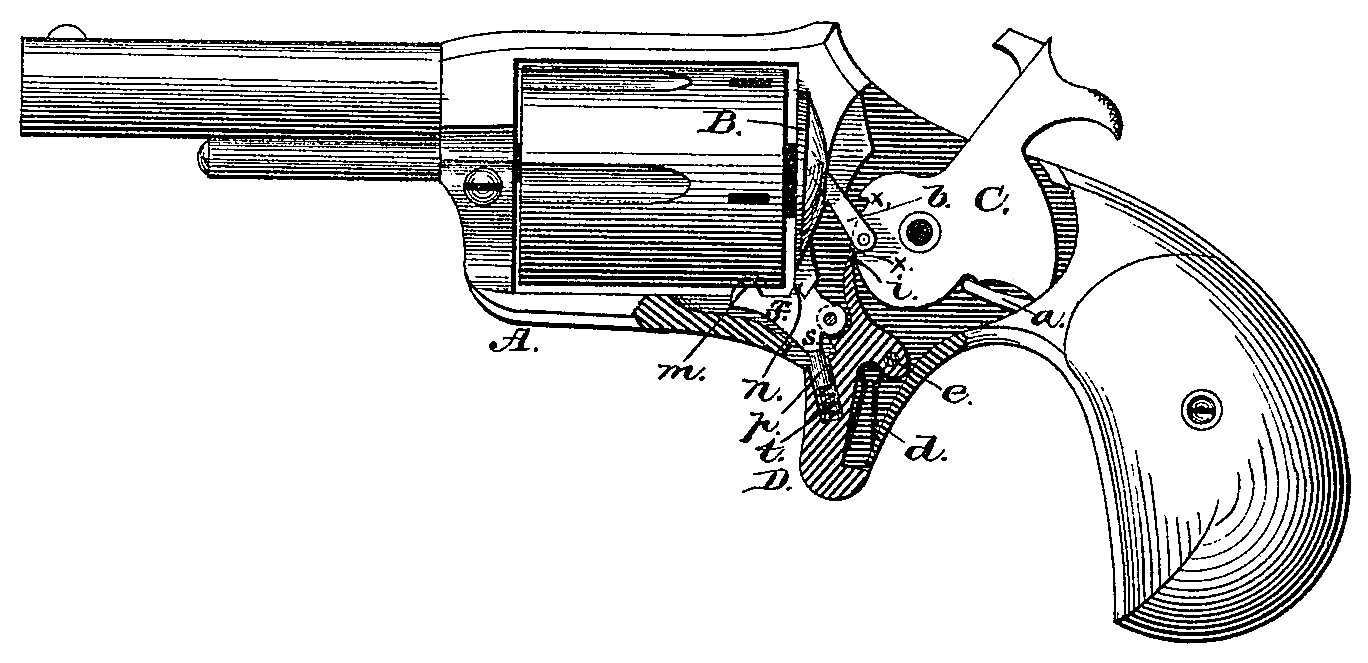US 210725
UNITED STATES PATENT OFFICE.
ALONZO L. SWEET, OF NORWICH, CONNECTICUT, ASSIGNOR OF ONE-HALF HIS RIGHT TO THE BACON ARMS COMPANY, OF SAME PLACE.
IMPROVEMENT IN REVOLVING FIRE-ARMS.
Specification forming part of Letters Patent No. 20,725, dated December 10, 1878; application filed September 6, 1878.
To all whom it may concern:
Be it known that I, Alonzo L. Sweet, of Norwich, in the county of New London and State of Connecticut, have invented certain new and useful Improvements in Revolving Fire-Arms; and I do hereby declare that the following is a full, clear, and exact description thereof, which will enable others skilled in the art to which it appertains to make and use the same, reference being had to the accompanying drawings, and to the letters of reference marked thereon, which form a part of this specification.
My invention relates to revolving fire-arms; and it consists in the construction and arrangement of devices for stopping on the half-cock, as will be hereinafter more fully set forth.
The annexed drawing, to which reference is made, and which fully illustrates my invention, represents a section of the working parts of a revolver embodying my invention.
A represents the frame of a revolver, with recoil-shield B. C is the hammer, having the two notches x x, for half-cock and full-cock. a is the hammer-spring. l is the arm or pawl, pivoted on the hammer, and passing through a slot in the recoil-shield, to engage with the ratchet on the end of the cylinder for rotating the same.
D is the trigger, with spring d, and the point i, to catch in the notches on the hammer, the trigger being pivoted at e. In the front of the trigger D, a suitable distance below its upper end, is made a recess, in which is pivoted an arm, F. This arm extends forward, and lies in a groove in the lower strap of the frame, and the end of said arm provided on its upper side with a rounded lug or projection, m, to take into the usual notches made in the outer surface of the cylinder, for holding the same stationary. Near the pivoted end the arm F is formed with a V-shaped notch, which fits on a corresponding projection, n, on the bottom of the recoil-shield. On the under side of the arm F is formed a shoulder, s, against which works a pin, p. This pin is inserted in a hole made in the front edge of the trigger, and a spring, t, is below said pin, to hold the same against the shoulder s.
The stop, as usually arranged in revolving fire-arms is the most difficult to adjust, and unless the stop is perfect the weapon is dangerous to the person using the same.
By my invention the stop or arm F is worked by the trigger, it being connected thereto by a joint, so that the stop must work with the trigger.
In cocking the hammer, as soon as the half cock notch is reached by the trigger, the trigger-spring d throws the point i of the trigger into said notch. By this movement of the trigger the stop F is turned upon the V-shaped projection in as a fulcrum, sufficiently far to retract the lug in from the notch in the cylinder, and leave the cylinder free to be carried forward by the pawl b, thus bringing the next chamber in line with the barrel, at which time the spring-pin p in the trigger throws the stop into the notch in the cylinder, and locks it until the half-cock notch is reached again.
Safety in loading is also insured by the hammer being drawn back for half-cock only far enough to allow the cylinder to rotate, as then, even if the hammer should accidentally slip off half-cock, there is not force enough to explode the cartridge.
Having thus fully described my invention, what I claim as new, and desire to secure by Letters Patent, is—
In a revolving fire-arm, the combination of the trigger, the stop jointed to the trigger, a fulcrum on or below the recoil-shield for the stop, and a spring in the trigger for adjusting the stop, all substantially as and for the purposes herein set forth.
In testimony that I claim the foregoing as my own I affix my signature in presence of two witnesses.
ALONZO LOUIS SWEET.
Witnesses:
Norris G. Lippitt,
Stephen B. Meech.

